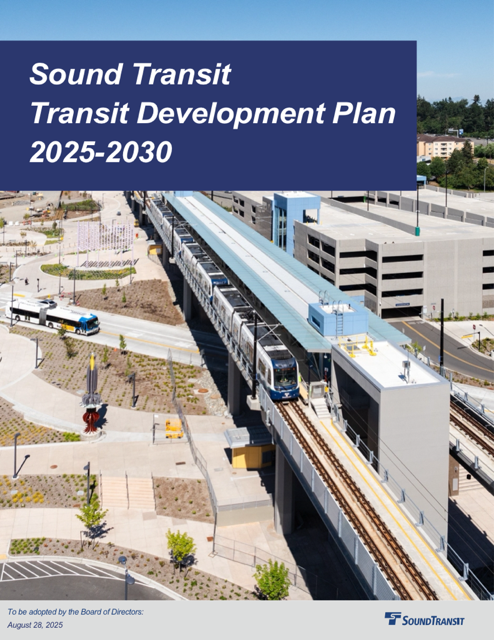Sound Transit releases 2025-2030 Transit Development Plan, outlines future service and capital investments
Sun, 07/27/2025
Sound Transit has released its 2025-2030 Transit Development Plan (TDP), providing an updated look at the agency's public transit services, planned expansions, and financial outlook. This comprehensive report, submitted annually to the Washington State Department of Transportation (WSDOT), serves as a key document for summarizing the status of public transportation systems across the state for the Washington State Legislature.
Download the plan here
The plan covers Sound Transit's current service modes, including ST Express (commuter bus), Sounder (commuter rail), T Line (light rail), and Link (light rail), along with planned capital expenses for the future Stride bus rapid transit service. The information presented in this report is current as of June 2025.
Public Engagement and Adoption Schedule Sound Transit is actively seeking public input on the TDP before its formal adoption. Key dates for public participation and plan finalization include:
• Public Comment Period: The opportunity for public comments is open from July 24, 2025, to August 7, 2025. Comments can be submitted via email to main@soundtransit.org or by mail to Sound Transit Service Planning and Development.
• Public Hearing: A public hearing on the Transit Development Plan is scheduled for August 7, 2025.
• Board Adoption: The Sound Transit Board of Directors is slated to adopt the Transit Development Plan on August 28, 2025.
• Plan Distribution: Following adoption, the plan will be distributed on September 1, 2025, to WSDOT, the Transportation Improvement Board, and all cities, counties, and regional transportation planning organizations within Sound Transit's operating area.
Notices of the hearing and availability of the plan were posted on Sound Transit's website and published in The Daily Journal of Commerce on July 24, 2025.
Highlights of the 2025-2030 Transit Development Plan The TDP details various aspects of Sound Transit’s operations and future plans:
• Service Area and Operations: The plan provides an overview of Sound Transit's service area, which aligns with urban growth boundaries in King, Pierce, and Snohomish counties, and includes details on the agency's various transit modes.
• Strategic Goals and Accomplishments: Sound Transit's strategies are aligned with six state transportation policy goals: Preservation, Safety, Stewardship, Mobility, Economic Vitality, and Environment. The agency highlighted 2024 accomplishments such as opening a new pedestrian bridge at Overlake Village Station, piloting a digital wayfinding tool, and earning awards for sustainable infrastructure.
• Performance Measures: Sound Transit measures system performance through its System Performance Tracker, focusing on accessibility, cleanliness, dependability, passenger information, and safety. The plan also sets targets for transit asset management, ensuring vehicles and facilities remain in a state of good repair.
• Planned Capital Expenses and Operating Changes: The plan outlines significant capital investments, including the final acceptance of 152 Siemens light rail vehicles in 2025 and an additional 10 in 2027. Major facility openings include new parking garages at Auburn and Kent Stations in 2025. The report also details planned operating changes through 2030, which involve restructuring existing ST Express bus services as new high-capacity transit projects, like Link light rail extensions, are completed.
◦ Significant expansions expected in 2026 include the full Link 2 Line extending to Downtown Redmond and Lynnwood City Center, and the Link 1 Line extending south to Federal Way with three new stations.
◦ Stride BRT service launches are anticipated in 2028 (S3 Line along SR 522 and S1 Line along I-405 South) and 2029 (S2 Line along I-405 North).
◦ The document notes that project delays have occurred due to factors such as the COVID-19 pandemic, labor market impacts, global supply chain issues, a regional concrete delivery strike, and construction quality issues. Therefore, proposed operating changes are not final and may be adjusted based on construction progress and operational capacity.
• Multiyear Financial Plan: The TDP includes a multiyear financial plan outlining capital and operating revenues and expenses. A full list of capital projects and their costs can be found in Appendix H of Sound Transit's 2025 Adopted Budget & Financial Plan.
• Projects of Regional Significance: Several major projects are identified as "projects of regional significance" as defined by the Puget Sound Regional Council. These include various Link projects, Sounder projects, and Stride BRT projects.
West Seattle Link Extension Details The West Seattle Link Extension (project T400047) is highlighted as one of Sound Transit's projects of regional significance. While the provided excerpts confirm its status and indicate that detailed capital costs can be found on page 152 of Appendix H in Sound Transit's 2025 Adopted Budget & Financial Plan, the specific timing and cost details for the West Seattle Link Extension are not present within these particular sources. For those details, readers would need to consult the full budget document.
Ridership Trends In 2024, Sound Transit served 42 million passenger trips, a 12% increase over 2023, indicating a continued recovery from the COVID-19 pandemic lows. The T Line saw the most significant ridership growth due to a recent extension, and Link light rail also experienced robust growth, benefiting from extensions to Northgate and Lynnwood, and the introduction of the 2 Line.
For more information, the full Transit Development Plan is available through Sound Transit's official channels.


